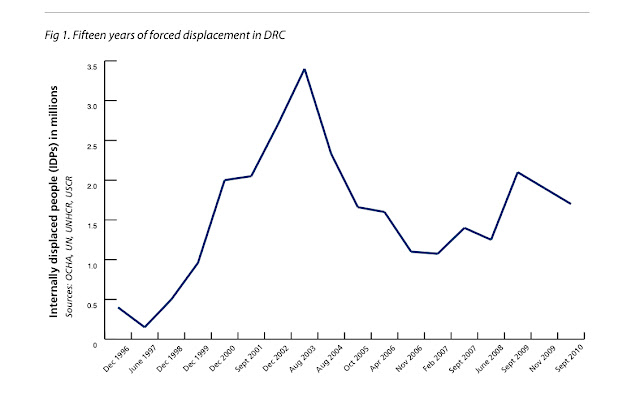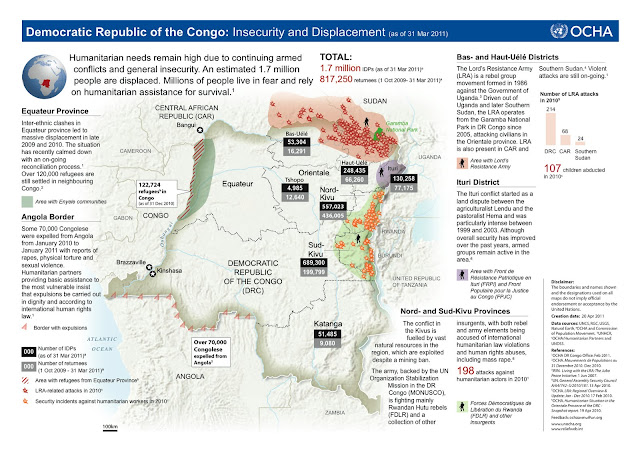Sometimes it’s good to take a step back and look at the Congo in historical perspective. So often we are bombarded by bad news stories in the press – not the least the recent rape statistics – that we lose perspective. After all, there have been some notable achievements since 2009: the main political faultline in the region between Congo and Rwanda has been patched over by a tenuous peace deal, Nkunda has been arrested and the CNDP semi-integrated into the Congolese army. A series of armed groups has also been semi-integrated (emphasis probably on « semi ») and the series of offensives by the Congolese army (Kimia II, Umoja Wetu, Amani Leo, Ruwenzori) has petered off a bit in 2011.
So is the situation on the ground better now than a year ago?
The short answer is that we don’t really know. Obviously, all the operations I mentioned above provoked massive human rights abuses and displacement. The event data is still pretty patchy, although Ushahidi is trying to do some rudimentary crowd-sourcing. One way of getting leverage on this question is by looking at displacement, as IDPs are somewhat easier to count than deaths or rapes. Here’s what we know:
July 2008: 1,25 million internally displaced people
November 2008: 1,4 million
July 2009: 2 million
September 2010: 1,7 million
March 2011: 1,7 million
There seems to be some discrepancy in the data from different sources. The above is from the Internal Displacement Monitoring Center. Here is a graph, however, that doesn’t quite jive with that:

In any case, it seems that most agree that IDP levels peaked at some point in 2009 and have been slightly decreasing since then. However, this belies the subnational variation: It is NOT the case, for example, that between the peak and now 300,000 people have gone home and there have been no new displacements. Instead, hundreds of thousands have gone home and hundreds of thousands of new displacements have occurred. While some areas have become more stable, others have become less so.
For example, the areas where much of the CNDP-FARDC fighting took place in 2008 (Masisi, Rutshuru) are now more stable, while the areas where the anti-FDLR operations have been taking place (Walikale, western Masisi and Lubero, Mwenga and Shabunda) are more dangerous now. In addition, while Ituri remains much less violent than 4 years ago, LRA attacks have displaced several hundred thousand in Province Orientale. Here is a good (and grim) picture of the situation, thanks to OCHA.

Finally, here is what a diplomat who lives in the region and follows the security situation very closely told me when I asked what the trend in the security situation was:
The smaller scale attacks and ambushes are definitely ongoing in much of Rutshuru, Masisi, Walikale, and Lubero. And in some places it’s gotten worse where the FARDC abandoned areas to join regiments, leaving a void, and then the FDLR or other armed groups moved in, attacking the population on their arrival.
There also seems to have been a significant amount of new displacement in the past month in Masisi and Lubero, but it’s not clear how many people fled and for what reasons exactly. There’ve been more clashes in the Lukweti area, but MONUSCO and most humanitarians still have no access to that region so it’s hard to know what’s really going on.
And then we still have all the targeted attacks, killings, disappearances, arbitrary arrests, etc. by Bosco and co. and other FARDC commanders, including in land-related conflicts.
